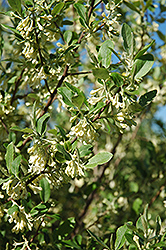It's all about ...
plants

Red Wing Autumn Olive
Elaeagnus umbellata 'Red Wing'
Height: 18 feet
Spread: 18 feet
Sunlight:
![]()
Hardiness Zone: 4a
Description:
A tough shrub used primarily for wildlife and conservation plantings, or for erosion control; attractive silver foliage, bright red berries in fall, a somewhat shrubby appearance; can self-seed vigorously, best in a natural environment
Ornamental Features
Red Wing Autumn Olive is primarily grown for its highly ornamental fruit. It features an abundance of magnificent red berries from mid to late fall. It has attractive silver deciduous foliage. The fuzzy oval leaves are highly ornamental but do not develop any appreciable fall colour. It features subtle fragrant white bell-shaped flowers along the branches in late spring.
Landscape Attributes
Red Wing Autumn Olive is a multi-stemmed deciduous shrub with an upright spreading habit of growth. Its relatively coarse texture can be used to stand it apart from other landscape plants with finer foliage.
This is a high maintenance shrub that will require regular care and upkeep, and is best pruned in late winter once the threat of extreme cold has passed. Gardeners should be aware of the following characteristic(s) that may warrant special consideration;
- Spreading
- Self-Seeding
Red Wing Autumn Olive is recommended for the following landscape applications;
- Hedges/Screening
- Naturalizing And Woodland Gardens
Planting & Growing
Red Wing Autumn Olive will grow to be about 18 feet tall at maturity, with a spread of 18 feet. It tends to be a little leggy, with a typical clearance of 2 feet from the ground, and is suitable for planting under power lines. It grows at a fast rate, and under ideal conditions can be expected to live for approximately 30 years.
This shrub should only be grown in full sunlight. It is very adaptable to both dry and moist locations, and should do just fine under average home landscape conditions. It is considered to be drought-tolerant, and thus makes an ideal choice for xeriscaping or the moisture-conserving landscape. It is particular about its soil conditions, with a strong preference for clay, alkaline soils, and is able to handle environmental salt. It is highly tolerant of urban pollution and will even thrive in inner city environments. This is a selected variety of a species not originally from North America.
This plant is not reliably hardy in our region, and certain restrictions may apply; contact the store for more information.
